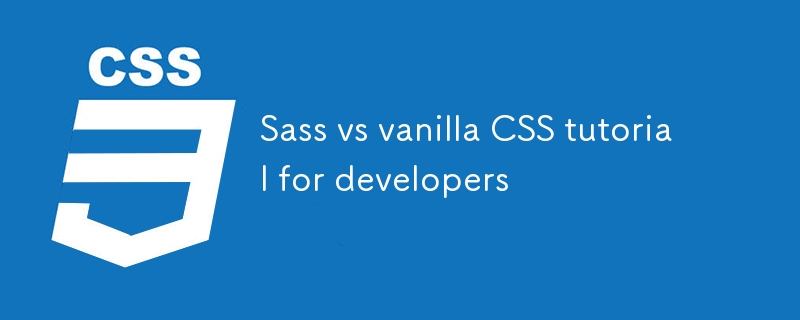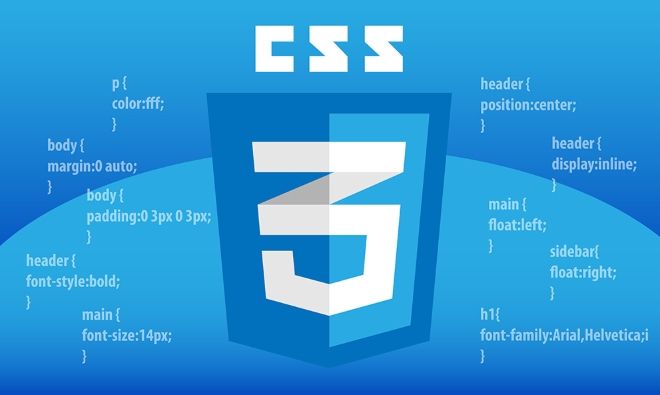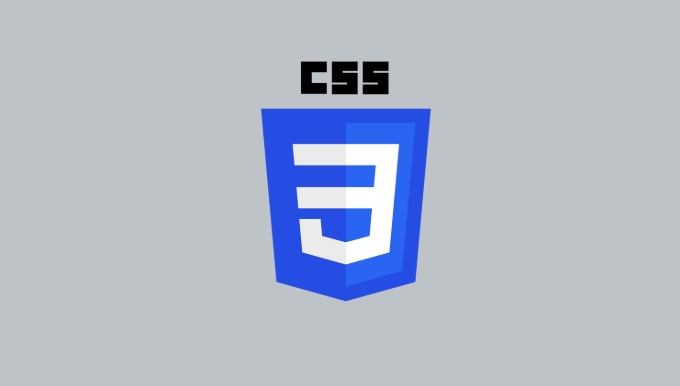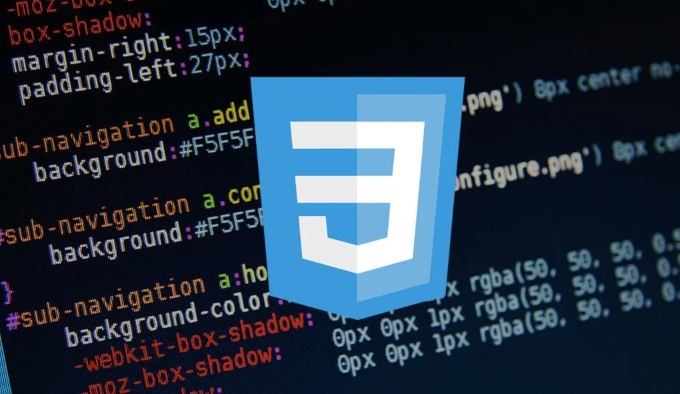It is worth learning Sass because it can significantly improve the efficiency and maintenance of style development. 1. The variable system is more intuitive and supports multiple data types, which facilitates the unified management of style values such as colors and fonts; 2. Nested syntax reduces duplicate selectors to make the structure clearer; 3. Mixins and functions improve style reuse capabilities, simplify complex tasks such as responsive design; 4. Compilation process needs to be configured, but modern tools are well supported. Suitable for medium and large projects, team collaboration and scenes that require theme switching.

You can write CSS and now want to try Sass, but aren't sure if it's worth spending time learning? In fact, Sass just adds some "sugar" to CSS, so that you can write styles more efficiently and have clearer structures. If you often do medium and large projects, or develop in collaboration with teams, the advantages of Sass will be obvious.

The following key points can help you determine whether to switch from vanilla CSS to Sass.

Variables make colors and fonts even easier
CSS itself also has variables (the type defined in :root ), but it is not flexible enough to use. Sass' variable system is more intuitive and supports various data types, such as numbers, strings, color values, etc.
For example:

$primary-color: #007bff;
$font-stack: 'Helvetica Neue', sans-serif;
body {
font-family: $font-stack;
color: $primary-color;
} In this way, you only need to change $primary-color once, and the theme color of the entire website will change, and you don’t need to replace each file.
Suitable for scenarios:
- Long-term maintenance projects
- Front-end engineering with multi-person collaboration
- Design system that requires theme switching function
Nested writing reduce duplicate selector
In CSS, writing nested structures is troublesome, and you have to write the parent selector over and over again. Sass supports nested syntax and the structure is clear at a glance.
for example:
.navbar {
background: #333;
color: white;
a {
text-decoration: none;
color: inherit;
}
}After compilation, it is:
.navbar {
background: #333;
color: white;
}
.navbar a {
text-decoration: none;
color: inherit;
}However, be careful not to embed too deeply, otherwise the generated CSS level will be too complex, which will affect performance and maintainability.
Mixins and functions improve multiplexing capabilities
Mixins is a highlight of Sass, which is equivalent to a function in the code, which can encapsulate commonly used style blocks or browser prefix processing logic.
For example, make a responsive breakpoint mixin:
@mixin tablet {
@media (min-width: 768px) {
@content;
}
}
.container {
width: 100%;
@include tablet {
width: 750px;
}
}This is much more convenient than copying and pasting code in every media query. And you can make all the commonly used tool classes into mixins and manage them in a unified manner.
The compilation process requires some configuration
Sass is not a native browser-supported language, so you have to add a compilation step. The most common way is to use sass or sass-loader (if it is a Webpack project) to translate the .scss file to normal CSS.
Simple command line usage:
sass input.scss output.css
If you are using modern build tools (Vite, Webpack, Parcel), you usually just need to install the dependencies and automatically handle them. But for those who have just started it, this process may be a bit unfamiliar.
Frequently asked questions include:
- Listen to file changes not correctly set
- The output path is incorrect, resulting in the style not loading
- Confusing the indentation syntax of SCSS and older versions of Sass (
.sass)
Basically that's it. Sass is not a must, but it can indeed help you save a lot of repetitive labor in actual development. If the project structure you are writing now is relatively complex or you want to improve the efficiency of style organization, then Sass is a good choice. It is not as basic as CSS, but it is not difficult to learn. The key is to understand how several of its core functions are used in daily work.
The above is the detailed content of Sass vs vanilla CSS tutorial for developers. For more information, please follow other related articles on the PHP Chinese website!

Hot AI Tools

Undress AI Tool
Undress images for free

Undresser.AI Undress
AI-powered app for creating realistic nude photos

AI Clothes Remover
Online AI tool for removing clothes from photos.

Clothoff.io
AI clothes remover

Video Face Swap
Swap faces in any video effortlessly with our completely free AI face swap tool!

Hot Article

Hot Tools

Notepad++7.3.1
Easy-to-use and free code editor

SublimeText3 Chinese version
Chinese version, very easy to use

Zend Studio 13.0.1
Powerful PHP integrated development environment

Dreamweaver CS6
Visual web development tools

SublimeText3 Mac version
God-level code editing software (SublimeText3)

Hot Topics
 What is 'render-blocking CSS'?
Jun 24, 2025 am 12:42 AM
What is 'render-blocking CSS'?
Jun 24, 2025 am 12:42 AM
CSS blocks page rendering because browsers view inline and external CSS as key resources by default, especially with imported stylesheets, header large amounts of inline CSS, and unoptimized media query styles. 1. Extract critical CSS and embed it into HTML; 2. Delay loading non-critical CSS through JavaScript; 3. Use media attributes to optimize loading such as print styles; 4. Compress and merge CSS to reduce requests. It is recommended to use tools to extract key CSS, combine rel="preload" asynchronous loading, and use media delayed loading reasonably to avoid excessive splitting and complex script control.
 External vs. Internal CSS: What's the Best Approach?
Jun 20, 2025 am 12:45 AM
External vs. Internal CSS: What's the Best Approach?
Jun 20, 2025 am 12:45 AM
ThebestapproachforCSSdependsontheproject'sspecificneeds.Forlargerprojects,externalCSSisbetterduetomaintainabilityandreusability;forsmallerprojectsorsingle-pageapplications,internalCSSmightbemoresuitable.It'scrucialtobalanceprojectsize,performanceneed
 Does my CSS must be on lower case?
Jun 19, 2025 am 12:29 AM
Does my CSS must be on lower case?
Jun 19, 2025 am 12:29 AM
No,CSSdoesnothavetobeinlowercase.However,usinglowercaseisrecommendedfor:1)Consistencyandreadability,2)Avoidingerrorsinrelatedtechnologies,3)Potentialperformancebenefits,and4)Improvedcollaborationwithinteams.
 CSS Case Sensitivity: Understanding What Matters
Jun 20, 2025 am 12:09 AM
CSS Case Sensitivity: Understanding What Matters
Jun 20, 2025 am 12:09 AM
CSSismostlycase-insensitive,butURLsandfontfamilynamesarecase-sensitive.1)Propertiesandvalueslikecolor:red;arenotcase-sensitive.2)URLsmustmatchtheserver'scase,e.g.,/images/Logo.png.3)Fontfamilynameslike'OpenSans'mustbeexact.
 What is Autoprefixer and how does it work?
Jul 02, 2025 am 01:15 AM
What is Autoprefixer and how does it work?
Jul 02, 2025 am 01:15 AM
Autoprefixer is a tool that automatically adds vendor prefixes to CSS attributes based on the target browser scope. 1. It solves the problem of manually maintaining prefixes with errors; 2. Work through the PostCSS plug-in form, parse CSS, analyze attributes that need to be prefixed, and generate code according to configuration; 3. The usage steps include installing plug-ins, setting browserslist, and enabling them in the build process; 4. Notes include not manually adding prefixes, keeping configuration updates, prefixes not all attributes, and it is recommended to use them with the preprocessor.
 What are CSS counters?
Jun 19, 2025 am 12:34 AM
What are CSS counters?
Jun 19, 2025 am 12:34 AM
CSScounterscanautomaticallynumbersectionsandlists.1)Usecounter-resettoinitialize,counter-incrementtoincrease,andcounter()orcounters()todisplayvalues.2)CombinewithJavaScriptfordynamiccontenttoensureaccurateupdates.
 CSS: When Does Case Matter (and When Doesn't)?
Jun 19, 2025 am 12:27 AM
CSS: When Does Case Matter (and When Doesn't)?
Jun 19, 2025 am 12:27 AM
In CSS, selector and attribute names are case-sensitive, while values, named colors, URLs, and custom attributes are case-sensitive. 1. The selector and attribute names are case-insensitive, such as background-color and background-Color are the same. 2. The hexadecimal color in the value is case-sensitive, but the named color is case-sensitive, such as red and Red is invalid. 3. URLs are case sensitive and may cause file loading problems. 4. Custom properties (variables) are case sensitive, and you need to pay attention to the consistency of case when using them.
 Case Sensitivity in CSS: Selectors, Properties, and Values Explained
Jun 19, 2025 am 12:38 AM
Case Sensitivity in CSS: Selectors, Properties, and Values Explained
Jun 19, 2025 am 12:38 AM
CSSselectorsandpropertynamesarecase-insensitive,whilevaluescanbecase-sensitivedependingoncontext.1)Selectorslike'div'and'DIV'areequivalent.2)Propertiessuchas'background-color'and'BACKGROUND-COLOR'aretreatedthesame.3)Valueslikecolornamesarecase-insens






